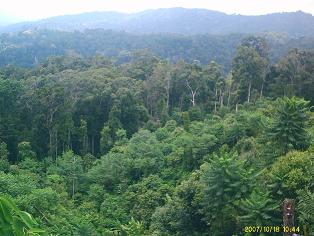|
The value of rain forests

|
Rain forests benefit people in four major ways. They provide (1) economic, (2) scientific, (3) environmental, and (4) recreational value.
Economic value. Wood ranks as the most important rain forest product. Foresters harvest millions of trees from rain forests each year. People use about 80 percent of rain forest wood for fuel and about 20 percent for timber. International trade in tropical hardwoods averages billions of dollars a year. Other valuable rain forest resources include fibers, fruits, nuts, oils, and resins. Indonesia and the Philippines export millions of dollars in furniture and other products made from rattan, a kind of palm. Amazon rain forests provide thousands of tons of Brazil nuts and rubber. Mexican and Central American forests yield various types of chicle, a natural latex once widely used in chewing gum.
|
Scientific value. Tropical rain forests have much to teach people. Many scientists study the rain forest as an ecosystem-that is, they investigate the relationships among all its living things and the environment that supports them. Because of its great diversity of life, the rain forest ranks as the most complex ecosystem on land. Biologists have discovered and classified only a small percentage of the organisms believed to live there. As scientists learn more about rain forests, they can better understand how to conserve these and other ecosystems.
Rain forests provide a wealth of foods and medicines. The forest peoples of Borneo use hundreds of different plant species for food. Most of these plants have not been grown outside Borneo. About 85 wild relatives of the common avocado exist in forests of Central America. Commercial avocado growers are working with scientists to develop ways of using these species to breed avocados that are more resistant to disease.
Several important medicines come from rain forest plants. These include quinine, used to treat malaria; tubocurarine, a muscle relaxant sometimes used in heart surgery; and pilocarpine, used to treat the eye disease glaucoma. The rosy periwinkle plant from Madagascar yields important anticancer drugs. Scientists believe many more potential medicines may exist in rain forests.
Environmental value. Tropical rain forests help regulate the earth's environment in several ways. For example, tropical trees help control the amount of rain water that reaches the ground. These trees absorb an enormous quantity of rain. In a process called transpiration, much of this water evaporates from the trees' leaf pores and reenters the atmosphere as vapor. Eventually, the vapor condenses into water and falls to the earth again as rain. Transpiration may account for as much as half of the rainfall in some rain forests. By regulating rainfall, rain forest trees keep floods and droughts from becoming too severe. The dense rain forest vegetation also reduces soil erosion.
Rain forests help control temperatures in their own regions and in other parts of the world. Rain forest trees absorb light and heat. This absorption keeps tropical climates from becoming too hot or too cold. The forests also take in and store massive amounts of carbon dioxide, preventing the build-up of this gas in the atmosphere.
|
Scientists believe the accumulation of carbon dioxide and other gases in the atmosphere increases temperatures around the world. By absorbing carbon dioxide, tropical rain forests may help keep worldwide temperatures from becoming too warm.
Recreational value. Rain forests offer great beauty, lush vegetation, and unique wildlife for tourists. A growing number of people travel to rain forests each year. Tourism has helped increase awareness of the need to preserve these environments.
Next >>> |
Contributor:
Charles M. Peters, Ph.D., Kate E. Tode Curator of Botany, The New York Botanical Garden.
..
|
|

